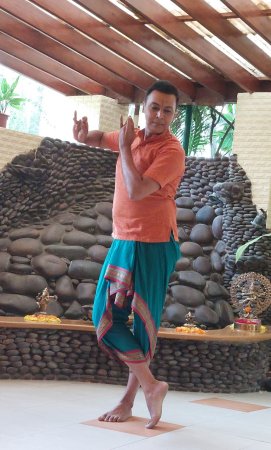
|   |

|   |
Vaibhav's tryst with theatrical dance - Vijay Shanker e-mail: vijaydance@gmail.com April 11, 2022 Samskara Academy of Fine Arts presented a lecture-demonstration on Bharatanatyam by one of the leading male classical dancers of Mumbai, Vaibhav Arekar, at the Theosophical Colony premises, Juhu, Mumbai on 20th March. The interactive closed session was attended by young aspirants of dance, professional dancers and veterans like Manipuri exponent Darshana Jhaveri and Oddissi exponent Daksha Mashruwala. Vaibhav Arekar was a lecturer at Nalanda Nritya Kala Mahavidyalaya and has sought guidance in abhinaya from the founder director of Nalanda, Dr Kanak Rele. He formed his own group of dancers and has had the privilege of dancing for some of the most prestigious festivals in both India and abroad. Over the years, Vaibhav has experimented with the dance style with new choreography and themes that are relevant to the society, like ‘Narmade Har Har’, winning accolades for his performances pertaining to theatrical dance.  Vaibhav commenced his performance with the traditional Alarippu and narrated as to how and why he proceeded on to theatrical dance, in order to enhance the aspect of storytelling through dance and also to portray the significance of the theme selected for the occasion. Vaibhav said, “It was a festival with Sangeeta Natak Akademi that I happened to delve deep into the subject matter of the river Narmada and its relevance to the society, by and large. With the introduction of different themes, I started getting invitations from theatre festivals like Prithvi festival. Within the traditional framework of Bharatanatyam, taking certain liberties according to the scenes and subjects required, I use movements of Kathakali, Yakshagana and the typical aharya of these styles too in order to suit the character represented, with theatrical direction from Sushant Jadhav.” Vaibhav performed an extract from ‘Narmada Har Har’, exposing the graceful and lyrical movements of the flowing river, popular ashtapadi of Jayadeva’s “Priye Charusheele.” Normally women are always depicted suffering from the pangs of separation (viraha tapam) but this ashtapadi is an exception, wherein Krishna repents and calls forth Radha, addressing her as “Priye Charusheele.” Vaibhav is a devoted performer and has the ability to get completely involved with the presentation. He concluded with a brief and rhythmic Thillana. After the performance, the interactive session started. Darshana Jhaveri remarked, “I appreciate new innovations but I really miss the dance in such experiments.” Daksha Mashruwala questioned as to how does one differentiate the movements pertaining to the traditional framework and new choreography to suit the story or theme portrayed. Vaibhav replied that he continues to dance traditional numbers within the framework but is always interested in new innovations. One of the students asked how he maintains his physique and he replied with regular dancing and discipline pertaining to health and well being. Bharatanatyam exponent Namita Bodaji, director of Samskara, said, “There is so much that one can learn from the experiences of another artiste. A dance performance not only should enthrall an audience but also inspire the future generation of dancers. This is exactly what my organization Samskara Academy of Fine Arts is working towards. In the past we have organized events like Pathik- lec dem series for outstation artistes. The idea was to invite them for a session for Samskara while they were in town for a performance. Samskara’s festival ‘Lakshita’ has presented some brilliant classical dancers in the past. Vaibhav Arekar's lec dem for Samskara was a captivating session. My students had so much to discuss in the next class. I truly believe that we have to expose the younger generation of dancers to the varied styles of performers. They need to observe the tradition along with the evolving and path breaking works too. An intimate session that is interactive can bridge the gap between the stage and the audience.”  Vijay Shankar is a Kuchipudi and Kathakali exponent, teacher, bilingual journalist, arts critic and actor. |